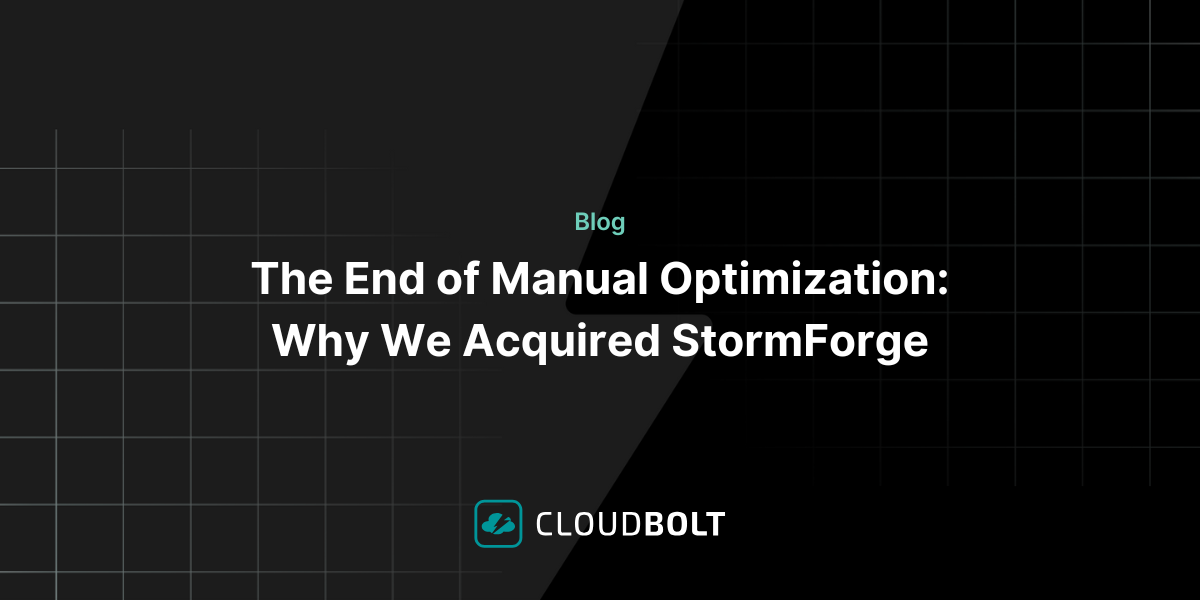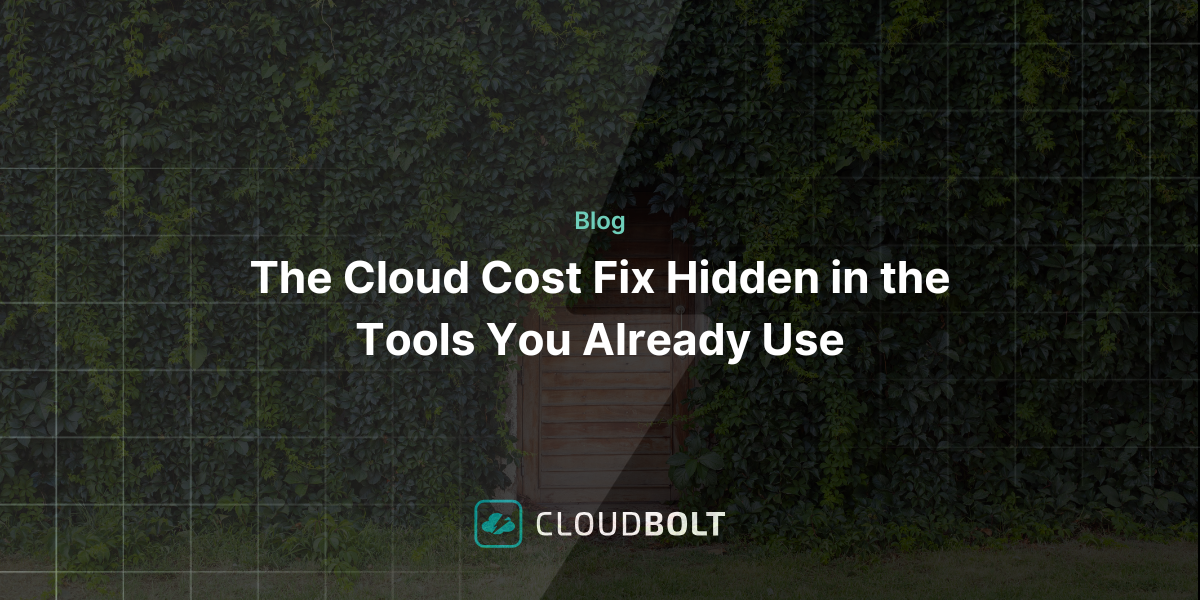Transforming FinOps Automation: Introducing CloudBolt’s Augmented FinOps
Imagine this: A cost anomaly is detected in your environment. You receive an automatic alert that the appropriate team has been notified to take immediate action. In just a matter of minutes, the issue is resolved, and AI and machine learning begin ingesting the data and further training the system. You sit back, take a sip of coffee, and dive into more strategic work.
Pretty cool, right? This vision represents an ideal future of FinOps automation—where company culture, operations, and technology are so aligned that insight-to-action occurs in minutes, sometimes even seconds!
As it stands today, however, the insight-to-action process can take weeks or months. That’s because the current state of FinOps automations is more like a series of episodic human activities than true continuous automation. FinOps practitioners still use spreadsheets or disparate tools to manually pull and aggregate data from various cloud providers, reconcile discrepancies, and analyze costs. Each step, from identifying cost-saving opportunities to implementing optimizations, is interrupted by approvals, reviews, and coordination among multiple stakeholders. This fragmented approach is extremely time-consuming and prone to inaccuracies.
Traditional FinOps Automation
To further illustrate this, consider the typical FinOps workflow broken down into four main steps: Acknowledge, Assign, Approval, and Action.
- Acknowledge: The process begins with acknowledging a cost-saving opportunity, which involves sifting through vast amounts of data. This data collection is often manual and time-consuming, creating the first significant delay.
- Assign: Once an opportunity is identified, it must be assigned to the appropriate team or individual. This step adds another layer of communication and coordination, often requiring input from multiple departments such as finance, engineering, and operations, which further slows the process.
- Approval: Before any action can be taken, the proposed optimization must undergo an approval process. This involves reviewing the potential impact, ensuring alignment with business objectives, and obtaining sign-offs from senior management or finance leaders. These approval workflows are typically managed through systems like ServiceNow, JIRA, or email, introducing additional delays as requests sit in queues waiting for review.
- Action: Finally, once approvals are in place, the assigned team can implement the optimization. However, even at this stage, execution can be delayed by the need to coordinate with other teams, schedule downtime, or verify changes.
Each of these steps introduces pauses and waiting periods, creating a disjointed, stop-and-go process that significantly delays the implementation of cost-saving measures.
The Right, Shift-Left, Approach
So how do companies overcome the roadblocks they’re facing in FinOps automation? The answer is clearly not to offload work to FinOps or DevOps teams themselves, which only adds to the unrealistic burden of managing an ever-growing complexity of cloud environments manually. Instead, it is shifting resolution left to advanced technology solutions that are designed to be the force multipliers to achieve the scale, accuracy, and automation required to truly solve advanced cloud cost problems such as waste reduction, chargeback/show back, unit economics, and optimized workload recommendations at the point of provisioning.
CloudBolt’s Augmented FinOps solution is designed to address these challenges head-on by transforming episodic FinOps automation into a continuous, efficient, and impactful process. With our new capabilities, CloudBolt customers can leverage the following:
- Unified View and Proactive Recommendations: Cost and usage data across all cloud providers are aggregated into a single, unified view. This comprehensive perspective enables FinOps leaders to see the big picture and drill down into specific areas of interest. By leveraging the unified data, the solution provides proactive cost optimization recommendations tailored to the organization’s unique environment.
- AI/ML-Driven Insights and Intelligent Automation: AI and machine learning identify inefficiencies and automatically recommend the best course of action, reducing manual intervention. For example, if an idle server is detected based on predefined rules, the system can automatically shut it down or reconfigure it, saving costs and improving efficiency.
- Automation of Key Processes: By pre-configuring robust automation workflows using multi-level logic and adaptable rules, FinOps practitioners no longer have the burden of manual tasks. This drastically shortens the insight-to-action time from weeks or months to mere minutes or hours, allowing organizations to quickly realize cost savings.
- Enhanced Collaboration and Transparency: Seamlessly integrates with existing enterprise ecosystems, including tools like Slack, JIRA, and ServiceNow. Improves collaboration between finance and engineering teams by providing clear, actionable insights and facilitating communication. The result is improved transparency and alignment among all stakeholders.
Continuous Automation with Augmented FinOps
To revisit the FinOps workflow illustration from earlier, here’s how the process looks like now with CloudBolt’s Augmented FinOps in action:
- Acknowledge and Assign: The steps of acknowledging cost-saving opportunities and assigning tasks are fully automated. The system continuously monitors cloud environments, identifies inefficiencies, and flags opportunities for optimization without requiring manual intervention. This automation ensures that opportunities are promptly recognized and routed to the appropriate workflows, eliminating delays associated with data collection and manual assignment.
- Approval: Once an optimization opportunity is identified and assigned, the system can significantly automate the approval process, where needed. Predefined rules and criteria can codify approvals for routine optimizations, while more complex or high-impact changes can be escalated for manual review. This approach accelerates the approval process, ensuring that only necessary human interventions are required.
- Action: After approval, the system can execute the optimization actions automatically. For instance, if the system identifies underutilized storage resources, it can automatically resize or decommission them based on predefined rules. This automation minimizes the need for manual execution and coordination, allowing optimizations to be implemented swiftly and efficiently.
At scale, these automated steps result in enormous savings and waste reduction, moving from simply sporadic gains to an ongoing, cumulative pile of benefits.
While we may not yet be soaking in FinOps’s perfected state of automation, CloudBolt’s Augmented FinOps moves us one step closer to the collective vision. By drastically reducing insight-to-action lead time, eliminating manual toil, and enhancing collaboration, our new service advisor experience empowers organizations to maximize their cloud ROI and achieve seamless, efficient cloud operations.
To learn more about CloudBolt’s Augmented FinOps, talk to us at FinOps X or visit cloudbolt.io/demo today.
Related Blogs

How I Rethought Cloud Budgeting—And What Finance Leaders Need to Know
If you’re a finance leader trying to bring more structure and strategy to cloud budgeting, you’re not alone. While most…

